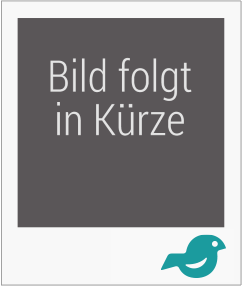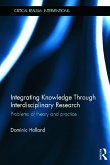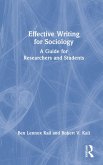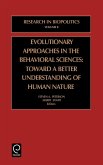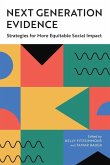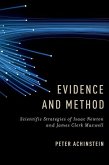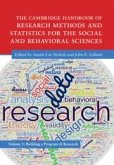Gary L. Brase
Integrating Converging Evidence in Behavioral Sciences
How to Incite a Scientific Revolution
Gary L. Brase
Integrating Converging Evidence in Behavioral Sciences
How to Incite a Scientific Revolution
- Gebundenes Buch
- Merkliste
- Auf die Merkliste
- Bewerten Bewerten
- Teilen
- Produkt teilen
- Produkterinnerung
- Produkterinnerung
This book presents a fresh approach to understanding the landscape of scientific research, particularly within the behavioral sciences. By examining the needs for consistency and coherence across different scientific disciplines, this book offers readers a practical framework for evaluating and advancing their research topics.
Andere Kunden interessierten sich auch für
![Integrating Knowledge Through Interdisciplinary Research Integrating Knowledge Through Interdisciplinary Research]() Dominic HollandIntegrating Knowledge Through Interdisciplinary Research176,99 €
Dominic HollandIntegrating Knowledge Through Interdisciplinary Research176,99 €![Evidential Pluralism in the Social Sciences Evidential Pluralism in the Social Sciences]() Yafeng ShanEvidential Pluralism in the Social Sciences167,99 €
Yafeng ShanEvidential Pluralism in the Social Sciences167,99 €![Effective Writing for Sociology Effective Writing for Sociology]() Ben KailEffective Writing for Sociology149,99 €
Ben KailEffective Writing for Sociology149,99 €![Evolutionary Approaches in the Behavioral Sciences Evolutionary Approaches in the Behavioral Sciences]() Albert Somit / Steven A Peterson (eds.)Evolutionary Approaches in the Behavioral Sciences197,99 €
Albert Somit / Steven A Peterson (eds.)Evolutionary Approaches in the Behavioral Sciences197,99 €![Next Generation Evidence Next Generation Evidence]() Next Generation Evidence50,99 €
Next Generation Evidence50,99 €![Evidence and Method Evidence and Method]() Peter AchinsteinEvidence and Method54,99 €
Peter AchinsteinEvidence and Method54,99 €![The Cambridge Handbook of Research Methods and Statistics for the Social and Behavioral Sciences The Cambridge Handbook of Research Methods and Statistics for the Social and Behavioral Sciences]() The Cambridge Handbook of Research Methods and Statistics for the Social and Behavioral Sciences191,99 €
The Cambridge Handbook of Research Methods and Statistics for the Social and Behavioral Sciences191,99 €-
-
-
This book presents a fresh approach to understanding the landscape of scientific research, particularly within the behavioral sciences. By examining the needs for consistency and coherence across different scientific disciplines, this book offers readers a practical framework for evaluating and advancing their research topics.
Produktdetails
- Produktdetails
- Verlag: Routledge
- Seitenzahl: 166
- Erscheinungstermin: 26. September 2025
- Englisch
- Abmessung: 250mm x 175mm x 14mm
- Gewicht: 477g
- ISBN-13: 9781032882826
- ISBN-10: 1032882824
- Artikelnr.: 74064874
- Herstellerkennzeichnung
- Libri GmbH
- Europaallee 1
- 36244 Bad Hersfeld
- gpsr@libri.de
- Verlag: Routledge
- Seitenzahl: 166
- Erscheinungstermin: 26. September 2025
- Englisch
- Abmessung: 250mm x 175mm x 14mm
- Gewicht: 477g
- ISBN-13: 9781032882826
- ISBN-10: 1032882824
- Artikelnr.: 74064874
- Herstellerkennzeichnung
- Libri GmbH
- Europaallee 1
- 36244 Bad Hersfeld
- gpsr@libri.de
Gary L. Brase is a professor in the Department of Psychological Sciences at Kansas State University, where he studies complex human decision-making using social, cognitive, and evolutionary theories.
Preface
Acknowledgements
1. A Quick Guide to Multi-Level Converging Lines of Evidence
Converging lines of Evidence
Multiple Levels of Explanation
The MCL framework.
Intentional Level
Algorithmic Level
Biological Level
Advantages of the framework
Putting the framework to work
Where to go from here
References
2. Historical and Philosophical Background of the MCL Framework
Convergence and Consistency
Converging Lines of Evidence
Schmitt and Pilcher's Multiple Lines of Evidence
Consistency across Multiple Levels
General Levels of Explanation
Tinbergen's four questions
Marr's Levels of Explanation
Prior Unification Frameworks
Unifying psychology
Unifying science
Summary of Historical Background
Philosophical Background and Issues
Truth and the Nature of Reality
Against Realism in Science
Supporting Realism
Consistency of Sciences
Modularity, Consciousness, and Free Will
Conclusion
Inciting scientific revolutions
References
3. Concerns, Digressions, and Extensions of the MCL Framework
Introduction
The Persistence of Inertia
The Parsimony versus Complexity Issue
The Difficulty of Interdisciplinarity
Do I really need evolution in this framework?
How Many Levels of explanation?
Intentional Level
Algorithmic Level
Biological Level
How many lines of evidence? and where?
Can This Framework Provide a Score?
How does this framework really lead to better hypotheses?
Improve traditional hypothesis testing
Move to Bayesian statistics
Move to multiple hypotheses
Does this framework make research more replicable?
Can this framework be manipulated?
Conclusion
References
4. Quick Illustrative Examples of the MCL Framework
Language
Learned Taste Aversion
Terror Management Theory
More Examples
Reasoning about Social Exchanges
Exploration versus exploitation in searching
Sex Differences in Wayfinding
Discussion
References
5. Rationality and Quantitative Reasoning, using the MCL Framework
Rationality
Two Visions of Rationality
Constrained Maximization and Dual-Process Models
The Bayesian Reasoning Crucible (part 1)
Satisficing, Extended Adaptations Views, and Favored formats models
The Bayesian Reasoning Crucible (part 2)
Summary
The Intentional Level
Theoretical Evidence on the nature of quantitative reasoning
Constrained maximization and dual-process models
Extended adaptations and favored formats models
Summary
Phylogenetic Evidence on the nature of quantitative reasoning
Constrained maximization and dual-process models
Extended adaptations and favored formats models
Summary
The Algorithmic Level
Psychological Evidence on the nature of quantitative reasoning
Constrained maximization and dual-process models
Extended adaptations and favored formats models
Summary
Developmental Evidence on the nature of quantitative reasoning
Constrained maximization and dual-process models
Extended adaptations and favored formats models
Summary
Cross-Cultural Evidence on the nature of quantitative reasoning
Constrained maximization and dual-process models
Extended adaptations and favored formats models
Summary
Ancestral Environments Evidence on the nature of quantitative reasoning
Constrained maximization and dual-process models
Extended adaptations and favored formats models
Summary
Medical Evidence on the nature of quantitative reasoning
Constrained maximization and dual-process models
Extended adaptations and favored formats models
Summary
The Biological Level
Physiological Evidence on the nature of quantitative reasoning
Constrained maximization and dual-process models
Extended adaptations and favored formats models
Summary
Genetic Evidence on the nature of quantitative reasoning
Constrained maximization and dual-process models
Extended adaptations and favored formats models
Summary
Conclusion
References
Acknowledgements
1. A Quick Guide to Multi-Level Converging Lines of Evidence
Converging lines of Evidence
Multiple Levels of Explanation
The MCL framework.
Intentional Level
Algorithmic Level
Biological Level
Advantages of the framework
Putting the framework to work
Where to go from here
References
2. Historical and Philosophical Background of the MCL Framework
Convergence and Consistency
Converging Lines of Evidence
Schmitt and Pilcher's Multiple Lines of Evidence
Consistency across Multiple Levels
General Levels of Explanation
Tinbergen's four questions
Marr's Levels of Explanation
Prior Unification Frameworks
Unifying psychology
Unifying science
Summary of Historical Background
Philosophical Background and Issues
Truth and the Nature of Reality
Against Realism in Science
Supporting Realism
Consistency of Sciences
Modularity, Consciousness, and Free Will
Conclusion
Inciting scientific revolutions
References
3. Concerns, Digressions, and Extensions of the MCL Framework
Introduction
The Persistence of Inertia
The Parsimony versus Complexity Issue
The Difficulty of Interdisciplinarity
Do I really need evolution in this framework?
How Many Levels of explanation?
Intentional Level
Algorithmic Level
Biological Level
How many lines of evidence? and where?
Can This Framework Provide a Score?
How does this framework really lead to better hypotheses?
Improve traditional hypothesis testing
Move to Bayesian statistics
Move to multiple hypotheses
Does this framework make research more replicable?
Can this framework be manipulated?
Conclusion
References
4. Quick Illustrative Examples of the MCL Framework
Language
Learned Taste Aversion
Terror Management Theory
More Examples
Reasoning about Social Exchanges
Exploration versus exploitation in searching
Sex Differences in Wayfinding
Discussion
References
5. Rationality and Quantitative Reasoning, using the MCL Framework
Rationality
Two Visions of Rationality
Constrained Maximization and Dual-Process Models
The Bayesian Reasoning Crucible (part 1)
Satisficing, Extended Adaptations Views, and Favored formats models
The Bayesian Reasoning Crucible (part 2)
Summary
The Intentional Level
Theoretical Evidence on the nature of quantitative reasoning
Constrained maximization and dual-process models
Extended adaptations and favored formats models
Summary
Phylogenetic Evidence on the nature of quantitative reasoning
Constrained maximization and dual-process models
Extended adaptations and favored formats models
Summary
The Algorithmic Level
Psychological Evidence on the nature of quantitative reasoning
Constrained maximization and dual-process models
Extended adaptations and favored formats models
Summary
Developmental Evidence on the nature of quantitative reasoning
Constrained maximization and dual-process models
Extended adaptations and favored formats models
Summary
Cross-Cultural Evidence on the nature of quantitative reasoning
Constrained maximization and dual-process models
Extended adaptations and favored formats models
Summary
Ancestral Environments Evidence on the nature of quantitative reasoning
Constrained maximization and dual-process models
Extended adaptations and favored formats models
Summary
Medical Evidence on the nature of quantitative reasoning
Constrained maximization and dual-process models
Extended adaptations and favored formats models
Summary
The Biological Level
Physiological Evidence on the nature of quantitative reasoning
Constrained maximization and dual-process models
Extended adaptations and favored formats models
Summary
Genetic Evidence on the nature of quantitative reasoning
Constrained maximization and dual-process models
Extended adaptations and favored formats models
Summary
Conclusion
References
Preface
Acknowledgements
1. A Quick Guide to Multi-Level Converging Lines of Evidence
Converging lines of Evidence
Multiple Levels of Explanation
The MCL framework.
Intentional Level
Algorithmic Level
Biological Level
Advantages of the framework
Putting the framework to work
Where to go from here
References
2. Historical and Philosophical Background of the MCL Framework
Convergence and Consistency
Converging Lines of Evidence
Schmitt and Pilcher's Multiple Lines of Evidence
Consistency across Multiple Levels
General Levels of Explanation
Tinbergen's four questions
Marr's Levels of Explanation
Prior Unification Frameworks
Unifying psychology
Unifying science
Summary of Historical Background
Philosophical Background and Issues
Truth and the Nature of Reality
Against Realism in Science
Supporting Realism
Consistency of Sciences
Modularity, Consciousness, and Free Will
Conclusion
Inciting scientific revolutions
References
3. Concerns, Digressions, and Extensions of the MCL Framework
Introduction
The Persistence of Inertia
The Parsimony versus Complexity Issue
The Difficulty of Interdisciplinarity
Do I really need evolution in this framework?
How Many Levels of explanation?
Intentional Level
Algorithmic Level
Biological Level
How many lines of evidence? and where?
Can This Framework Provide a Score?
How does this framework really lead to better hypotheses?
Improve traditional hypothesis testing
Move to Bayesian statistics
Move to multiple hypotheses
Does this framework make research more replicable?
Can this framework be manipulated?
Conclusion
References
4. Quick Illustrative Examples of the MCL Framework
Language
Learned Taste Aversion
Terror Management Theory
More Examples
Reasoning about Social Exchanges
Exploration versus exploitation in searching
Sex Differences in Wayfinding
Discussion
References
5. Rationality and Quantitative Reasoning, using the MCL Framework
Rationality
Two Visions of Rationality
Constrained Maximization and Dual-Process Models
The Bayesian Reasoning Crucible (part 1)
Satisficing, Extended Adaptations Views, and Favored formats models
The Bayesian Reasoning Crucible (part 2)
Summary
The Intentional Level
Theoretical Evidence on the nature of quantitative reasoning
Constrained maximization and dual-process models
Extended adaptations and favored formats models
Summary
Phylogenetic Evidence on the nature of quantitative reasoning
Constrained maximization and dual-process models
Extended adaptations and favored formats models
Summary
The Algorithmic Level
Psychological Evidence on the nature of quantitative reasoning
Constrained maximization and dual-process models
Extended adaptations and favored formats models
Summary
Developmental Evidence on the nature of quantitative reasoning
Constrained maximization and dual-process models
Extended adaptations and favored formats models
Summary
Cross-Cultural Evidence on the nature of quantitative reasoning
Constrained maximization and dual-process models
Extended adaptations and favored formats models
Summary
Ancestral Environments Evidence on the nature of quantitative reasoning
Constrained maximization and dual-process models
Extended adaptations and favored formats models
Summary
Medical Evidence on the nature of quantitative reasoning
Constrained maximization and dual-process models
Extended adaptations and favored formats models
Summary
The Biological Level
Physiological Evidence on the nature of quantitative reasoning
Constrained maximization and dual-process models
Extended adaptations and favored formats models
Summary
Genetic Evidence on the nature of quantitative reasoning
Constrained maximization and dual-process models
Extended adaptations and favored formats models
Summary
Conclusion
References
Acknowledgements
1. A Quick Guide to Multi-Level Converging Lines of Evidence
Converging lines of Evidence
Multiple Levels of Explanation
The MCL framework.
Intentional Level
Algorithmic Level
Biological Level
Advantages of the framework
Putting the framework to work
Where to go from here
References
2. Historical and Philosophical Background of the MCL Framework
Convergence and Consistency
Converging Lines of Evidence
Schmitt and Pilcher's Multiple Lines of Evidence
Consistency across Multiple Levels
General Levels of Explanation
Tinbergen's four questions
Marr's Levels of Explanation
Prior Unification Frameworks
Unifying psychology
Unifying science
Summary of Historical Background
Philosophical Background and Issues
Truth and the Nature of Reality
Against Realism in Science
Supporting Realism
Consistency of Sciences
Modularity, Consciousness, and Free Will
Conclusion
Inciting scientific revolutions
References
3. Concerns, Digressions, and Extensions of the MCL Framework
Introduction
The Persistence of Inertia
The Parsimony versus Complexity Issue
The Difficulty of Interdisciplinarity
Do I really need evolution in this framework?
How Many Levels of explanation?
Intentional Level
Algorithmic Level
Biological Level
How many lines of evidence? and where?
Can This Framework Provide a Score?
How does this framework really lead to better hypotheses?
Improve traditional hypothesis testing
Move to Bayesian statistics
Move to multiple hypotheses
Does this framework make research more replicable?
Can this framework be manipulated?
Conclusion
References
4. Quick Illustrative Examples of the MCL Framework
Language
Learned Taste Aversion
Terror Management Theory
More Examples
Reasoning about Social Exchanges
Exploration versus exploitation in searching
Sex Differences in Wayfinding
Discussion
References
5. Rationality and Quantitative Reasoning, using the MCL Framework
Rationality
Two Visions of Rationality
Constrained Maximization and Dual-Process Models
The Bayesian Reasoning Crucible (part 1)
Satisficing, Extended Adaptations Views, and Favored formats models
The Bayesian Reasoning Crucible (part 2)
Summary
The Intentional Level
Theoretical Evidence on the nature of quantitative reasoning
Constrained maximization and dual-process models
Extended adaptations and favored formats models
Summary
Phylogenetic Evidence on the nature of quantitative reasoning
Constrained maximization and dual-process models
Extended adaptations and favored formats models
Summary
The Algorithmic Level
Psychological Evidence on the nature of quantitative reasoning
Constrained maximization and dual-process models
Extended adaptations and favored formats models
Summary
Developmental Evidence on the nature of quantitative reasoning
Constrained maximization and dual-process models
Extended adaptations and favored formats models
Summary
Cross-Cultural Evidence on the nature of quantitative reasoning
Constrained maximization and dual-process models
Extended adaptations and favored formats models
Summary
Ancestral Environments Evidence on the nature of quantitative reasoning
Constrained maximization and dual-process models
Extended adaptations and favored formats models
Summary
Medical Evidence on the nature of quantitative reasoning
Constrained maximization and dual-process models
Extended adaptations and favored formats models
Summary
The Biological Level
Physiological Evidence on the nature of quantitative reasoning
Constrained maximization and dual-process models
Extended adaptations and favored formats models
Summary
Genetic Evidence on the nature of quantitative reasoning
Constrained maximization and dual-process models
Extended adaptations and favored formats models
Summary
Conclusion
References

